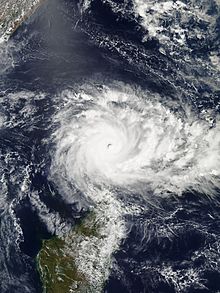 Fantala north of Madagascar on 18 April, shortly after peak intensity | |
| Meteorological history | |
|---|---|
| Formed | 11 April 2016 |
| Remnant low | 23 April 2016 |
| Dissipated | 27 April 2016 |
| Very intense tropical cyclone | |
| 10-minute sustained (MFR) | |
| Highest winds | 250 km/h (155 mph) |
| Highest gusts | 350 km/h (220 mph) |
| Lowest pressure | 910 hPa (mbar); 26.87 inHg |
| Category 5-equivalent tropical cyclone | |
| 1-minute sustained (SSHWS/JTWC) | |
| Highest winds | 285 km/h (180 mph) |
| Lowest pressure | 907 hPa (mbar); 26.78 inHg |
| Overall effects | |
| Fatalities | 13 total |
| Damage | $4.5 million (2016 USD) |
| Areas affected | |
| IBTrACS / [1] | |
Part of the 2015–16 South-West Indian Ocean cyclone season | |
Very Intense Tropical Cyclone Fantala was the most intense tropical cyclone recorded in the South-West Indian Ocean in terms of sustained winds. Part of the 2015–16 cyclone season, Fantala formed on 11 April to the south of Diego Garcia, an island in the central Indian Ocean. With a ridge to the south, the storm moved westward for several days while gaining strength, aided by warm waters and decreasing wind shear. Late on 17 April, the Météo-France office on Réunion (MFR) estimated peak 10-minute winds of 250 km/h (155 mph), making Fantala the strongest tropical cyclone of the basin in terms of 10-minute sustained winds. The Joint Typhoon Warning Center (JTWC) estimated peak 1-minute winds of 285 km/h (180 mph), equivalent to Category 5 intensity on the Saffir-Simpson scale, also the strongest on record in the South-West Indian Ocean, in terms of maximum sustained wind speed. Early on 18 April, Fantala reached its peak intensity, with a minimum central pressure of 910 millibars (27 inHg).
While near peak intensity, Fantala passed near the Farquhar Group of the Seychelles, damaging most of the buildings in the small archipelago. Later on 18 April, Fantala had weakened to an intense tropical cyclone and slowed its forward motion, eventually reversing its direction of movement. After fluctuating in strength, the disorganized system reversed direction again, making its closest approach to Madagascar. Fantala degenerated into a remnant low on 24 April, and the remnants continued toward Tanzania. There, heavy rainfall resulted in flooding that washed away roads and houses, killing 13 people. Rains extended further into Kenya, with similar effects.
- ^ Athanase, Patsy; Uranie, Sharon (17 May 2016). "$4.5 million in damages from cyclone that hit remote Seychellois island, World Bank says". Victoria, Seychelles. Seychelles News Agency. Retrieved 26 May 2016.